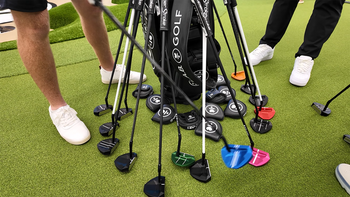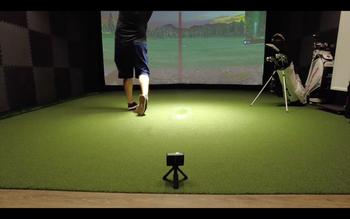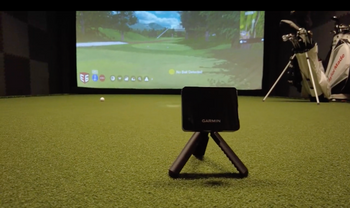Alright, today we’re talking about something that every golfer can use, a better way to practice. Specifically, we’re going to look at practice golf balls and separate the good ones from all of the junk that’s out there.
Now, look, I know that practicing golf balls isn’t the most exciting topic. But, hey, this is something that can benefit all of us. Whether you’re grinding on your swing in your garage, hitting chips in the backyard, or just looking to dial in your short game without running to the range, practice golf balls are a total game changer.
Let’s face it, most of us don’t have unlimited access to the range, and we’re not all out there playing three times a week. But what we do have, or what we can create, is a good home setup.
Maybe it’s a putting mat in the hallway. Maybe it’s a backyard chipping area. Or maybe it’s just a net in the garage where you can hammer a few 7-irons after work. Whatever your setup looks like, having the right practice golf balls makes all the difference.
And we’re not just talking about making it convenient. We’re talking about building confidence. You groove your swing, you work on your contact, and when you hit the course, it actually feels like you’ve been practicing with purpose.
But you’ve got to have the right golf balls to make your practice effective. And let’s be real: There are a lot of garbage practice golf balls out there. Stuff that doesn’t feel or perform at all like a real golf ball.
So that’s where I come in. I’m going to give you the 10 best practice golf balls of 2025. I’ve got picks here for indoor hitters, backyard bombers, short-game grinders — and even one that you can use with your golf launch monitor. Whether you're looking to enhance your visibility on the course or improve your overall performance, these selections cater to all skill levels. For instance, the Volvik Vivid golf balls features a vibrant, matte finish that makes them easy to track and find, a perfect choice for those who want to make a statement while playing. Get ready to elevate your game with these expertly chosen options that will suit every type of golfer. Whether you're looking to improve your distance off the tee or fine-tune your putting skills, there's a perfect option for everyone. Additionally, for those interested in exploring top-notch brands, the best Wilson golf balls reviewed will showcase a range of options that combine performance and value. Get ready to elevate your game with the right choice tailored to your playing style. Additionally, I’ll highlight some of the best affordable golf ball options that won’t break the bank but still deliver impressive performance on the course. Whether you’re looking to improve your distance or enhance your control around the greens, there’s something for every skill level. Get ready to elevate your game with these top selections that cater to every type of golfer.
Let’s get into it.
Table of Contents
BirdieBall Practice Golf Balls
Alright, we’re kicking this off with the BirdieBall, and yeah, there’s a reason this one gets the spotlight. It’s not just another foam ball. This thing is engineered to replicate the feel, the flight, and the spin of a real golf ball better than anything else.
Let’s start with what makes BirdieBall different, that oval-shaped design. At first glance, it looks kind of weird. But the magic is in the way it reacts to spin and impact. Hit a cut? You’ll see it tail off. Hook one? It’s gonna curve left. Hit it pure? You’ll see a satisfying, piercing ball flight that just makes you want to hit another one.
And the BirdieBall gives you true ball flight for up to 40 yards. That’s a ton of feedback, especially if you’re practicing full swings in limited space.
Guys, the thing I really like about these practice balls is that you can actually learn from your misses. Not just from the flight, but from the feel. You’ll know immediately if you toed it or if you flushed it dead center. That’s not something you usually get from a practice ball. And you don’t need 100 yards of space to see what’s happening.
The material is a dense, durable foam that feels surprisingly solid at impact. Not “rock hard” like a range ball, but way more realistic than your typical spongy foam options. And it’s also totally safe. So you can launch these in the backyard, in the garage, or into a net without worrying about broken windows or angry neighbors.
They’re also weather-resistant. You can hit these in cold or hot temps without them falling apart or warping over time.
You’ll see a lot of people using these at golf schools, which tells you everything you need to know. They’re designed by real golfers, and they’re built to make practice feel like golf.
If you’re serious about improving your swing at home, I think the BirdieBall is a no-brainer. It costs a little more than regular practice balls, but if you’re after realistic feel and feedback, it’s worth every penny.
BirdieBall Practice Golf Balls
Experience the award-winning BirdieBall Practice Golf Balls, realistic flight, true feedback, and limited to 40 yards for safe, anywhere practice.
AlmostGolf Balls
AlmostGolf balls are kind of the OG when it comes to realistic-feel foam balls. These have been around for years, and for good reason. They fly about a third of the distance of a regular golf ball, but they feel surprisingly close to the real thing. Many players have found them to be the best soft golf balls for distance, as they allow for a high level of practice without the risk of damaging property or injuring bystanders. Their lightweight design makes it easier to learn proper swing mechanics while still providing a realistic experience. This blend of safety and performance has solidified their spot in the bags of both beginners and seasoned golfers alike.
You get a little spin, a decent sound off the face, and enough feedback to know whether you caught it flush or hit a clunker. Great for backyard sessions, and they’re firm enough that you can use them with all of your clubs. They’re also lightweight and safe.
I wouldn’t consider these practice balls as advanced as BirdieBall in terms of spin feedback and just general realistic performance, but this is still one of the most trusted and consistent options out there if your looking for a foam practice golf ball.
AlmostGolf Balls
Experience premium practice with AlmostGolf Balls, engineered for true flight, unmatched durability, and safe play anywhere you want to improve your game.
GoSports Foam Practice Balls
For the money, it’s hard to beat the GoSports Foam Practice Balls. These have a realistic dimple pattern, a nice soft feel, and they’re just plain fun to hit.
They don’t fly as far or as true as BirdieBall or AlmostGolf, but for working on tempo and contact in your backyard or basement, they’re totally solid. And the color variety makes it super convenient when you’re picking them out of the grass. You even get a little carry bag for keeping them organized.
If you’re a casual player or just want something affordable to keep your swing loose between rounds, these are a great budget pick.
GoSports Foam Practice Balls
Elevate your training with GoSports Foam Practice Balls, premium, durable, and safe for indoor or outdoor use. Perfect for honing your swing skills!
Joyberg Practice Golf Balls
These are your classic hollow plastic balls, often called wiffle balls, but the Joybergs are actually pretty decent. They’ve got a 42mm diameter and a 26-hole design to keep flight consistent.
They don’t feel like a real golf ball by any stretch, but they’re perfect for limited-space chipping practice. They won’t break windows or bounce too far, and the bright multicolor pack makes them easy to spot in the grass.
Not the most durable, and they’ll dent over time, but for what they are, they’re a fun and affordable way to practice.
Joyberg Practice Golf Balls
Elevate your game with Joyberg Practice Golf Balls, premium, durable, and designed for realistic flight. Perfect your swing with every shot!
SKLZ Limited-Flight Practice Balls
SKLZ makes a lot of training gear, and their Limited-Flight Impact Balls are a notch up from typical plastic. These are regulation size and feel more solid than hollow balls, with a flight distance that caps around 45 yards.
They’re dent-resistant, surprisingly durable, and provide better feedback than a wiffle-style ball. I also like the pop-back tech. The ball deforms on impact and snaps back to shape, which is kind of cool and gives you a sense of how clean your strike was.
A little pricey for 12 balls, but a solid middle-ground option if you’re not into foam but want more realism than plastic.
SKLZ Limited-Flight Practice Balls
SKLZ Limited-Flight Practice Balls feature durable pop-back technology, offering a realistic feel and limited flight for effective training in small spaces.
Titleist Pro V1 RCT Golf Balls
If you’re using a radar-based launch monitor, this is your ball. The Titleist Pro V1 RCT is designed with a proprietary radar capture technology, giving you ultra-precise spin and launch data indoors.
These are legit Pro V1s, same feel, same premium performance, just with a special marker embedded in the core to make them radar-friendly. They’re not for everyone, but if you’re serious about simulator work, this is the best you can get.
Definitely not a backyard practice ball. This is for the data nerds and indoor training setups. High price tag, but for the right golfer, it’s a powerful tool.
Titleist Pro V1 RCT Golf Balls
Experience unmatched indoor performance with Titleist Pro V1 RCT Golf Balls, premium feel, precise radar data, and elite spin for serious golfers. These golf balls not only enhance your control around the greens but also provide exceptional distance off the tee. If you're seeking the ultimate in performance, be sure to check out the best Titleist golf balls review to see how the Pro V1 RCT stacks up against other top contenders on the market. Elevate your game and impress your partners with the precision and consistency that come with every swing.
ProActive Sports Pro Flight Practice Balls
Simple, lightweight, and super limited in flight, these ProActive Sports Pro Flight Balls are ideal for tiny backyards or indoor swings where space is tight.
They fly up to about 40 feet, so you won’t get much feedback on ball flight, but for working on swing mechanics and tempo, they’ll get the job done. They’re kind of like the training wheels of the practice ball world.
Not my top choice for realism, but a good safe option for beginners or indoor use.
ProActive Sports Pro Flight Practice Balls
Experience premium golf training with ProActive Sports Pro Flight Practice Balls, durable, realistic flight, perfect for honing your swing anywhere.
GoSports Pure Strike Training Discs
These aren’t actually golf balls at all. They’re flat discs made to teach you how to strike the ball clean. The idea is simple: if you can consistently clip one of these discs off the turf, your ball contact is probably going to be great.
These are good for working on low-point control, especially with wedges and short irons. If you chunk it, you’ll just whiff. If you think it, the disc won’t move. But get your mechanics right, and they pop off the ground with a satisfying little skip.
Super useful as a training aid, and they’re surprisingly fun to use. Not a substitute for hitting balls, but definitely a solid companion to your practice routine.
GoSports Pure Strike Training Discs
Elevate your game with GoSports Pure Strike Training Discs, premium, durable discs designed for precise footwork and elite soccer training.
Callaway HX Soft Flight Foam Balls
These are premium foam balls with Callaway’s HEX dimple pattern, which helps them fly straighter and more consistently than most foam options.
They’re soft enough to use indoors, but dense enough to hold their line outdoors, too. They fly about 60 to 70 percent of a real golf ball’s distance, so they’re great for backyard swings without going full send.
They also come in a carry pouch and a bunch of high-vis colors, which is cool.
To me, this one is not quite as realistic as BirdieBall, but it’s a better option than most.
Callaway HX Soft Flight Foam Balls
Callaway HX Soft Flight Foam Balls feature durable foam, a patented HEX dimple pattern, and a mesh carry bag, perfect for safe, realistic practice anywhere.
The Big Ball Golf Putting Trainer
The Big Ball is just what it sounds like. It’s a ball that’s 25 percent larger and 30 grams heavier than a standard golf ball. And it’s designed to make putting practice harder. Which in turn makes real putting feel easier.
The idea is that if you can roll this oversized ball on line, you’ll build confidence and improve face control. It forces you to commit to the stroke and really focus on your start line.
This isn’t a miracle fix, but for a simple training tool, it’s surprisingly effective.
The Big Ball Golf Putting Trainer
Elevate your short game with The Big Ball Golf Putting Trainer, 25% larger for sharper focus, improved accuracy, and lower scores on every green.
Practice Smarter, Not Just More
So there you have it, guys, 10 of the best practice golf balls (and training aids) you can get your hands on in 2025.
Whether you’re grinding indoors, chipping in the yard, or setting up the ultimate garage simulator, there’s something here to help you get better without even leaving your home.
Remember, the most important part of practice isn’t just hitting more balls. It’s hitting with intent. The right practice ball helps you work on the right things. Strike. Tempo. Confidence. And yeah, even fun. Because if it’s not fun, you’re not going to stick with it.
If you’ve used any of these, or if you’ve got a favorite I missed, let me know in the comments. And, as always, be sure to subscribe for more honest gear reviews and guides.
Now get out there, get to work, and start dialing in that game. And I’ll see you out on the course.
Frequently Asked Questions
Are practice golf balls different from regular golf balls?
Yes, practice golf balls are designed differently from regular golf balls. They typically have a shorter flight distance and less spin, making them ideal for practicing in confined spaces or at driving ranges. Additionally, they are built to be more durable to withstand repeated hits without wearing out quickly.
What types of practice golf balls are available?
There are several types of practice golf balls, including foam balls, plastic balls, and range balls. Foam and plastic balls are great for indoor or limited-space practice, while range balls are more durable and provide better feedback for outdoor practice sessions.
Can I use high-quality golf balls for practice?
Absolutely! Practicing with high-quality golf balls can help you get more accurate feedback on your shots. This is especially important if you're trying to replicate real-game conditions during your practice sessions. Using the same ball type for both practice and play ensures consistency in performance.
How long do practice golf balls last?
Practice golf balls are designed to be more durable than regular golf balls, especially range balls that are built to withstand repeated impacts. Depending on usage and the type of ball, they can last a long time before needing replacement.
Should beginners use different practice golf balls than advanced players?
Yes, beginners may benefit from using distance-oriented practice balls that offer forgiveness and help improve their long shots. Advanced players, on the other hand, might prefer premium practice balls that offer better spin control and feel around the greens.

























